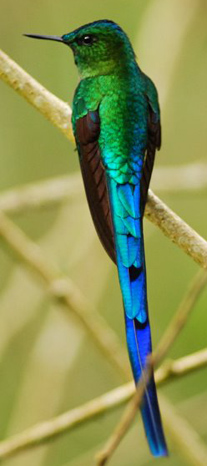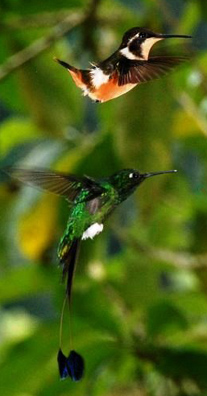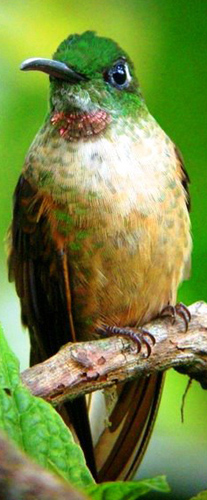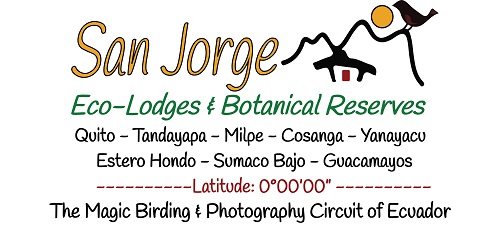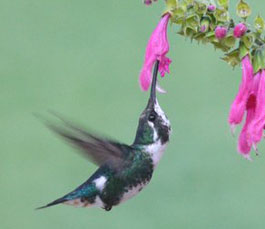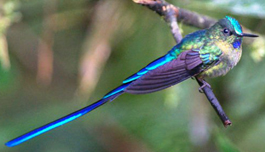THE MAGIC BIRDING CIRCUIT HUMMINGBIRDS OF ECUADOR
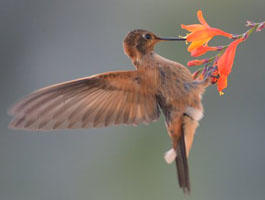 |
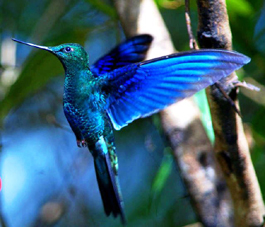 |
|
|
Ecuador is an ecological miracle. It is no larger than the state of Colorado and ranks among the top ten most ecologically diverse countries in the world. Ecuador is also a wonderful place to watch hummingbirds. Hummingbirds are an important part of Quito’s cultural ancestry, as well as that of all America: A “Land of Hummingbirds ". Many of Ecuador's hummingbirds are brightly-colored and some are so distinctive than even the most inexperienced bird-watcher can easily identify them.
Due to the variations in altitude, made possible by the presence of the Andes Mountains, and our position on the Equator, Ecuador is a unique place on Earth – one of the geographical areas that contain practically all of the climate steps in the world! It is because of this location on the globe that we are home to so many birds; there’s something for everyone! Hummingbirds in Ecuador can be found in nearly every type of habitat from sea level to the snow capped mountains and can even be found in city centers of large towns. The most amazing ones occupy the high altitude regions of the Andes right up to the glaciers of 5000 meters. To survive that high up, those species of colibries (Spanish for hummingbirds) go into a state of torpor at night, diminishing their heart rate and dropping body temperature by 25° Celsius to conserve energy in the cold and often freezing paramo nights.
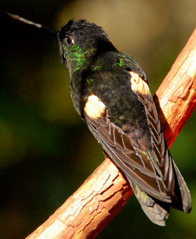 |
Also, did you know that Ecuador holds the world record for the number of hummingbird species in one country? Well, we do! Ecuador is home to over 132 species of hummingbirds grouped into 57 genera, representing almost half of all hummingbirds found worldwide. Hummingbirds are a very unique bird; they’ve adapted to any type of climate and altitude by changing their feathers, bill and size to adapt. It’s very interesting to observe how there are a higher number of species in less extreme areas. As we move towards more intense, harsh conditions, the number of species dramatically reduces to a handful. History shows that hummingbirds may have originally appeared in warmer, more tropical areas and, as they began to colonize areas outside of their comfort zone, their bodies changed to accommodate their new conditions.
Hummingbirds are the only type of bird which can fly backwards. The posture of a hummingbird can help indicate which family it belongs to. The hermits have long curved bills and tend to tuck their tails slightly under making them look as if they are curved forwards. They often hover with their bodies in a nearly vertical position. Woodstars, small with short tails and straight bills, tend to hold their bodies more horizontally with their tails sticking upwards. They can also hover in mid-air and can even fly upside down. Although the 'elbow' and 'wrist' joints are fused so the wings do not bend in the middle, hummingbirds have 180º of motion at the shoulder joint.
The distinctive humming noise is made by their wings, moving at up to 70 or 80 beats per second for the smallest hummingbirds. The Giant hummingbird beats its wings only around 10 times per second. Most middle-sized hummingbirds flap their wings at around 20-25 beats per second, or 1200 to 1500 beats per minute. In order for various hummingbird species to coexist, the abundance of epiphyte or parasite plants is vital. These plants seem to be "tailor-made" for the hummingbirds’ beaks. Such is the case of many bromeliads in the montane forests on the slopes of the Andes.
In order to feed from the flowers’ nectar, hummingbirds have developed a unique locomotion system, comparable only with that of insects: vibratory flight. This type of flight allows the birds to be suspended in the air in front of a flower, and also fly backwards and switch flying speed as desired. The smallest hummingbirds can move their wings at about 80 wing cycles per second. A hummingbird flies at about 200 times its length per second!
The most attractive part of the hummingbirds is the entire bird themselves. Their feathers vary in size and color and most color changes appear to be based on the sun’s rays. Their highly-specialized bill is a certain shape and size, based on what type of flower they gather nectar from. For example, the hermits have a curved bill, allowing them to drink nectar from the “bird of paradise” plant, which holds a similar shape.
The hummingbird only uses the Sucrose from the nectar. Sucrose comprises between 13% and 30% of the total nectar gathered. Because the sugar content is so low, the hummingbird is forced to visit several flowers, thus pollinating many plants per bird. Hummingbirds also eat insects, since they provide a wealth of protein, essential for growth and constant maintenance. As a very active bird, the hummingbird is constantly feeding. Normally going out for a snack every 10 minutes or so, their heart pumps about 600 times per minute, making their metabolism outrageously high. With such a high metabolism, it’s no wonder these tiny creatures need to constantly eat!
The hummingbird quiets down and hibernates like a polar bear at night. Then, once the first light of day breaks, they’re out for another super active day! Reproduction occurs during the highest point of flower production, since food is plentiful. With October through March being the rainy season, you can assume what the hummingbirds are up to!
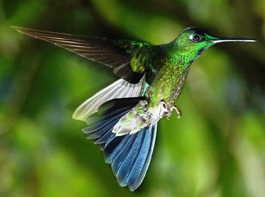 |
I am very sure that if Charles Darwin had not arrived in the Galapagos Islands, but instead had arrived in Continental Ecuador, he would have used hummingbirds as the best evidence for his theory of evolution. There is no other bird with such morphological adaption to their habitat and food. Darwin could have selected for his scientific exploration the Sword-billed Hummingbird, the Tawny Bellied Hermit and the Purple Backed Thornbill. This last one is located at Hosterìa San Jorge/Quito, in the eastern foothills of the Pichincha mountain range. For sure, Darwin would be curious seeing this hummingbird flying in the cold and very high habitat of the Ecuadorian highlands.
The Sword Billed Hummingbird lives in the temperate zones between 2500 to 3500 meters o.s.l. in the Andean range. The curious thing about this big hummer, compared with the size of his cousins, is that it has an enormous bill which is not in harmony with his body. The bird looks like his favorite flower, the long and colored Guanto Rojo (Guantus guantus). This species develop a tremendous bill to permit it to absorb the valuable nectar which is the basis for its subsistence. The bill also distributes pollen in nature. This hummingbird can be seen in Hosteria San Jorge/Quito.
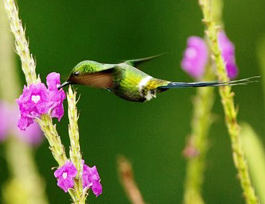 |
The Tawny Bellied Hermit is a hummingbird that lives in cloud forests and in subtropical areas. His habitat ranges from 1300 to 2200 meters o.s.l. in both Ecuadorian Andes ranges (east and west). The bird is considered middle sized-it is not the biggest or smallest of the hummingbirds. The bill is curved and long almost like the White Tipped Sickelbill. This bird is structured so his bill can absorb properly the nectar of his specialized flower the heliconias. This popular “bird of the paradise” plant
requires birds to have a curved and long beak in order to reach the nectar. This also guarantees the future existence of the bird of the paradise as the bird acts as a polinizer. It is easy to find this bird flying freely in the surroundings of San Jorge de Tandayapa Hummingbird Reserve in the Cloud Forest.
Other great example of adaptation according to necessity is the Purple Backed Thornbill. It is localized in two Andes ranges and always in temperate forests between 2500 and 3400 meters o.s.l. The bird is scarce but sometimes you can find them in small groups. This hummer has the smallest bill of all hummingbirds in Ecuador! He does not need a long bill since they love to absorb the nectar of the Sacha Capulì (Valea stipularis). This bush produces a small pink flower. Other wonderful example of adaptation!
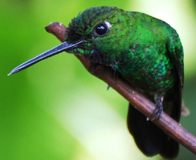 |
If Darwin climbed the Pichincha mountain and a how small hummer actively flies between the Chuquirahuas bushes (Chuquiraga jussieui), surrounded by a cold and windy glacier environment at high altitude, he probley would have immediately started to look for scientific explanation! We are now referring to the hummingbird Ecuadorian Hillstar. This is a subspecies that lives only in the Chimborazo mountain which has the highest altitude for all around of Ecuador: from 3600 to 460 meters o.s.l.!!! This bird has adapted his body to extreme climate situations such as extremely cold temperatures, glacial winds, short food variety, etc. None of these elements affect him! Very interesting, right?
Join in on one of our Magic Birding Circuit tours next time you are in Quito. Our four private birding reserves offer up to 60 possible hummingbirds species on our trails, with feeders for viewing at all three birding lodges. We welcome your visit soon!
The lodges and surrounding gardens/grounds are immaculately maintained and set in the most beautiful scenic surrounds. The staff are extremely friendly and it feels like they can't do enough for you. The food was absolutely delicious authentic Ecuadorian food and there was so much of it! The birdlife is staggering. An array of hummingbirds buzz around your breakfast table or bedroom window dashing from flower/feeder to flower/feeder. We saw emerald toucanettes, toucans, cock of the rock, quetzals, all sorts of tanangers...the list is endless! It seemed every which way we turned another brightly coloured bird was there to amaze us. Our guides were wonderful, spotting birds we never would of seen or found by ourselves. They were so enthusiastic and passionate and had excellent English speaking skills.
Dana ~ Brisbane, Australia
The three Lodges I visited, San Jorge Eco-Lodge, Tandayapa and Milpe are fantastic locations for seeing and photographing Humming Birds without having to walk any great distances. The staff are incredibly efficient, attentive and accommodating. They will give you space if you need it and literally "jump" whenever you ask for any assistance, not that one expected the "jump". I was amazed at how flexible they were when it came to arranging meal-times etc and how helpful they were when it came to sharing their knowledge of birds. Tandayapa, for example is one of the most beautiful places I have visited due to the fact that the clouds constantly change the mood of the place. It warrants a day or two just sitting in the rooms which have beautiful/majestic views of the Cloud Forests and a few days more enjoying the birds. The whole visit from booking to departure ran like clockwork and my only disappointment was that I did not add a few extra days at Tandayapa. The birds kept me glued to the feeder area and I only enjoyed glimpses of the lovely forest when waking and just before nightfall.
Tony – Cape Town, South Africa
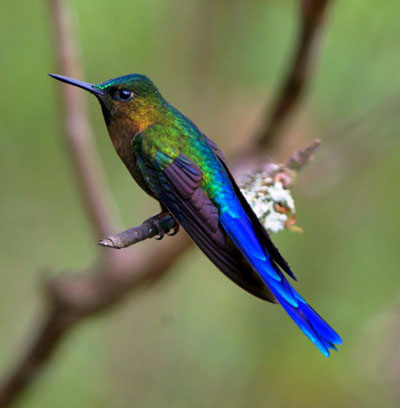
Hummingbirds Ecuador
Cheryl Korowotny
International Director
The Magic Birding & Photography Circuit
SAN JORGE ECO-LODGES & BOTANICAL RESERVES
Quito – Tandayapa – Milpe - Cosanga - Estero Hondo-Sumaco Bajo-Guacamayos
Ecuador – South America
Email: birdwatching@eco-lodgesanjorge.com
(877) 565-2596 Toll Free USA & Canada.
Magic Birding & Photography Circuit Map
San Jorge has been awarded the Trip Advisor Certificate of Excellence for the past 11 consecutive years!


